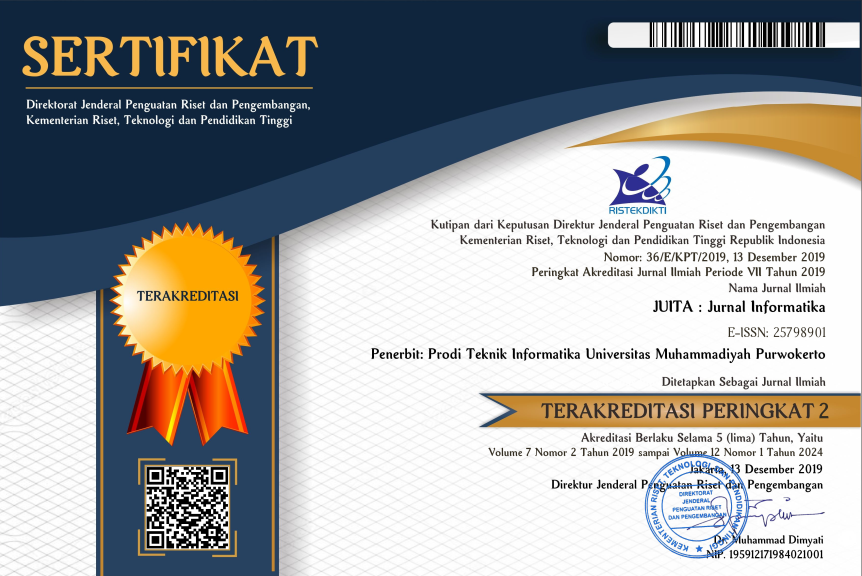K-Means Clustering for Grouping Rivers in DIY based on Water Quality Parameters
Abstract
Keywords
References
[1] B. Jogja, “Data Laju Pertumbuhan Penduduk di DIY,” 2020. http://bappeda.jogjaprov.go.id/dataku/data_dasar/index/701-penduduk (accessed Jan. 02, 2023).
[2] B. Warsito, S. Sumiyati, H. Yasin, and H. Faridah, “Evaluation of river water quality by using hierarchical clustering analysis,” 2021, doi: 10.1088/1755-1315/896/1/012072
[3] Z. Di, M. Chang, and P. Guo, “Water Quality Evaluation of the Yangtze River in China Using Machine Learning Techniques and Data Monitoring on Different Time Scales,” Water, vol. 11, no. 2, p. 339, 2019, doi: https://doi.org/10.3390/w11020339
[4] O. Herliana, T. S. Widodo, and I. Soesanti, “Klasifikasi Nomsupervised Citra Thermal Kanker Payudara Berbasis Fuzzy C-MEANS,” Jnteti, vol. 1, no. 3, pp. 1–5, 2012, doi: 10.22146/jnteti
[5] H. A. Nugroho, D. Hardiyanto, and T. B. Adji, “Nipple detection to identify negative content on digital images,” in Proceeding - 2016 International Seminar on Intelligent Technology and Its Application, ISITIA 2016: Recent Trends in Intelligent Computational Technologies for Sustainable Energy, 2016, pp. 43–48. doi: 10.1109/ISITIA.2016.7828631
[6] D. Hardiyanto, S. Kristiyana, D. Kurniawan, and D. A. Sartika, “Klasifikasi Motif Citra Batik Yogyakarta Menggunakan Metode Adaptive Neuro Fuzzy Inference System,” Setrum Sist. Kendali-Tenaga-elektronika-telekomunikasi-komputer, vol. 8, no. 2, p. 229, 2019, doi: 10.36055/setrum.v8i2.6545
[7] D. A. Sartika, H. Arrosida, and D. Hardiyanto, “Implementasi Teknik Klasifier Adaptive Neuro Fuzzy Inference System Untuk Mengklasifikasi Motif Citra Batik Jawa Timur,” Setrum Sist. Kendali-Tenaga-elektronika-telekomunikasi-komputer, vol. 11, no. 1, pp. 126–134, 2022, doi: 10.36055/setrum.v11i1.14872
[8] I. Rish, “An empirical study of the naive Bayes classifier,” IJCAI 2001 Work Empir Methods Artif Intell, vol. 3, no. 22, pp. 4863–4869, 2001, doi: 10.1039/b104835j
[9] L. Wenchao, Z. Yong, and X. Shixiong, “A Novel Clustering Algorithm Based on Hierarchical and K-means Clustering,” in Chinese Control Conference, 2007, pp. 605–609, doi: 10.1109/CHICC.2006.4347538
[10] H. Sulatri and A. I. Gufroni, “Penerapan Data Mining Dalam Pengelompokkan Penderita Thalassaemia,” J. Nas. Teknol. dan Sist. Inf., vol. 3, no. 2, pp. 299–305, 2017, doi: https://doi.org/10.25077/TEKNOSI.v3i2.2017.299-305
[11] O. Mohammadrezapour, O. Kisi, and F. Pourahmad, “F. Fuzzy c-means and K-means clustering with genetic algorithm for identification of homogeneous regions of groundwater quality,” Neural Comput. Appl., vol. 32, no. 8, pp. 3763–3775, 2020, doi: https://doi.org/10.1007/s00521-018-3768-7
[12] T. Zubaidah, N. Karnaningroem, and A. Slamet, “K-means method for clustering water quality status on the rivers of Banjarmasin, Indonesia,” ARPN J. Eng. Appl. Sci., vol. 13, no. 6, 2018. doi:10.31227/osf.io/s9n2u
[13] D. A. I. C. Dewi and D. A. K. Pramita, “nalisis Perbandingan Metode Elbow dan Silhouette pada Algoritma Clustering K-Medoids dalam Pengelompokan Produksi Kerajinan Bali,” Matrix J. Manaj. Teknol. dan Inform., vol. 9, 2019, doi: 10.31940/matrix.v9i3.1662
[14] A. Muhariya, I. Riadi, and Y. Prayudi, “Cyberbullying Analysis on Instagram Using K-Means Clustering,” JUITA J. Inform., vol. 10, no. 2, p. 261, 2022, doi: 10.30595/juita.v10i2.14490
[15] F. Indriyani and E. Irfiani, “Clustering Data Penjualan pada Toko Perlengkapan Outdoor Menggunakan Metode K-Means,” JUITA J. Inform., vol. 7, no. 2, p. 109, 2019, doi: 10.30595/juita.v7i2.5529
[16] M. Nishom, S. F. Handayani, and D. Dairoh, “Pillar Algorithm in K-Means Method for Identification Health Human Resources Availability Profile in Central Java,” JUITA J. Inform., vol. 9, no. 2, p. 145, 2021, doi: 10.30595/juita.v9i2.9860
[17] T. N. Hidayat, F. A. Purnomo, and Y. Yudhanto, “PDAM Performance Clustering using K-Means,” in 1st International Conference on Smart Technology, Applied Informatics, and Engineering (APICS), 2022, pp. 148–152, doi: 10.1109/APICS56469.2022.9918683
[18] I. M. Erwandi, “Pengelompokan kemiskinan Kabupaten/Kota di Papua dengan menggunakan metode K-Means,” UIN Sunan Ampel Surabaya, 2021.
[19] M. A. Nahdliyah, T. Widiharih, and A. Prahutama, “METODE k-MEDOIDS CLUSTERING DENGAN VALIDASI SILHOUETTE INDEX DAN C-INDEX (Studi Kasus Jumlah Kriminalitas Kabupaten/Kota di Jawa Tengah Tahun 2018),” Gaussian, vol. 8, no. 2, pp. 161–170, 2019, doi: https://doi.org/10.14710/j.gauss.8.2.161-170
[20] Admin, “Indeks Kualitas Lingkungan Hidup (IKLH) DIY,” yogyakarta, 2020. [Online]. Available: https://dlhk.jogjaprov.go.id/indeks-kualitas-lingkungan-hidup-iklh-diy.
DOI: 10.30595/juita.v11i1.16986
Refbacks
- There are currently no refbacks.

This work is licensed under a Creative Commons Attribution 4.0 International License.
ISSN: 2579-8901
- Visitor Stats
View JUITA Stats










